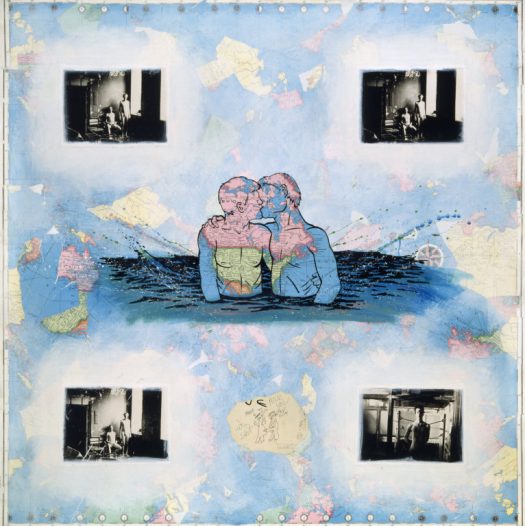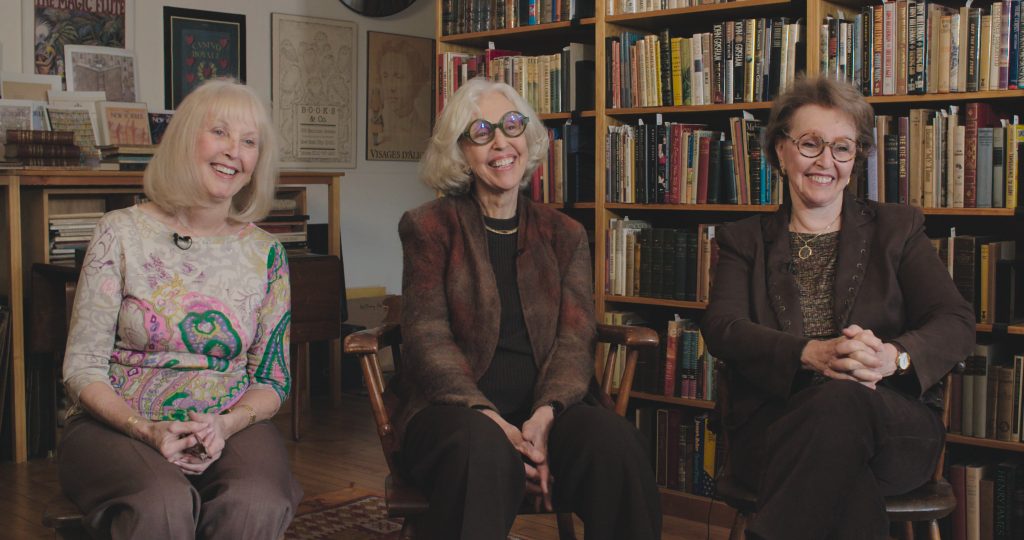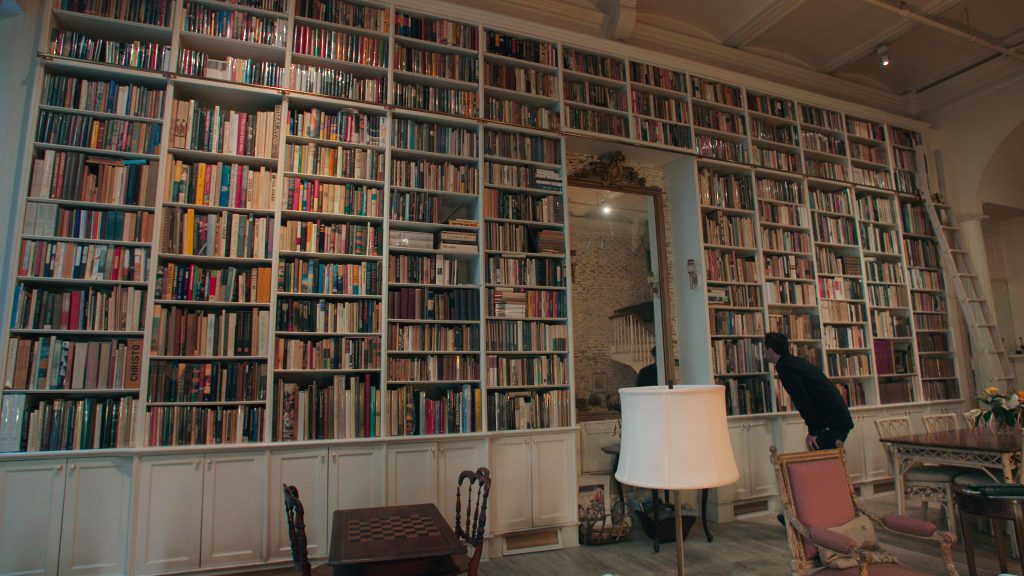April 8, 2021
by Carla Hay

Directed by Chris McKim
Culture Representation: The documentary “Wojnarowicz” features a nearly all-white group of people (and one African American), mostly from the U.S. avant-garde/experimental art community, discussing the life and legacy of New York City-based artist/activist David Wojnarowicz, who died of AIDS in 1992, at the age of 37.
Culture Clash: Wojnarowicz battled against homophobia, HIV/AIDS bigotry and right-wing conservatives who thought that his art was too obscene to be displayed in mainstream galleries.
Culture Audience: “Wojnarowicz” will appeal primarily to people interested in the history of the New York City art scene from the 1980s to early 1990s, as well as stories about influential AIDS activists.

Some artists want to keep politics out of their work. But the late artist/activist David Wojnarowicz believed that every work of art is some kind of political statement. The illuminating documentary “Wojnarowicz” tells his life story in a way that would have gotten Wojnarowicz’s approval: by crafting the movie like a cinematic version of an art installation retrospective. Directed by Chris McKim, much of the foundation of the “Wojnarowicz” documentary comes from Wojnarowicz’s diary-like audio recordings, journals, photos and Super 8 films that he made from his early 20s until his tragic death from AIDS in 1992, at the age on 37. Many of Wojnarowicz’s loved ones, friends and associates provide commentary, but their interviews (with a few exceptions) are voiceovers only in the movie.
If people put together a list of 20th century visual artists from New York City’s avant-garde art scene who were controversial and unapologetically presented gay/queer erotica in their art, then Robert Mapplethorpe and Wojnarowicz would definitely be on the list. Wojnarowicz wasn’t as famous as Mapplethorpe, who preceded Wojnarowicz and broke barriers for LGBTQ-themed art in the 1970s. However, Wojnarowicz was more versatile (Mapplethorpe’s main art form was photography, while Wojnarowicz created art in many forms), and Wojnarowicz was a lot more outspoken about his political views than many of his contemporaries.
Because much of the “Wojnarowicz” documentary is told in Wojnarowicz’s voice from his personal recordings, it gives viewers an insightful look into his personality and his innermost thoughts. He had a lot of anger and cynicism, but he could also be very sensitive and empathetic. The documentary includes some audio from media interviews that he did, but they aren’t as interesting as the private recordings that he made to document his life.
The movie also reveals a treasure trove of mementos and previously unreleased footage that undoubtedly make this documentary the definitive visual biography of Wojnarowicz. It’s an impressive historical perspective of the New York avant-garde art scene in the mid-1980s to early 1990s. Based on who’s interviewed in “Wojnarowicz,” director McKim wanted to include, with few exceptions, people who knew Wojnarowicz personally to give their comments for the movie. You won’t find Wojnarowicz’s critics or talking heads who never met Wojnarowicz taking up too much of the documentary’s time with any of their opinions.
Those interviewed in the documentary include retired social worker Tom Rauffenbart (who was Wojnarowicz’s boyfriend from the late 1980s until Wojnarowicz’s death) and Wojnarowicz older brother Steven. Also interviewed are Cynthia Carr, author of “Fire in the Belly: The Life and Times of David Wojnarowicz” and art critic Carlo McCormick. Other commentators include David Kiehl, curator emeritus of the Whitney Museum of American Art; Stephen Koch, author/director of the Peter Hujar Archive; gallery owner/curator Barry Blinderman; Anita Vitale, formerly of the New York City AIDS Case Management Unit; and Dr. Bob Friedman, who was Wojnarowicz’s physician when Wojnarowicz was living with AIDS.
But the people who have the most to say in the documentary are those who were Wojnarowicz’s contemporaries in New York City’s avant-garde and bohemian artists scene. They include writer Fran Lebowitz; filmmaker Richard Kern; Civilian Warfare gallery co-founder Alan Barrows; artist/collaborator Kiki Smith; filmmaker/photographer Marion Scemama; photographer Dirk Rowntree; curator Nan Goldin; artist Judy Glantzman; Gracie Mansion Gallery founder Gracie Mansion; former Gracie Mansion employee Sur Rodney Sur; P.P.O.W. Gallery co-founders Wendy Olsoff and Penny Pilkington; and former 3 Teens Kill 4 bandmates Jesse Hutberg, Doug Bressler, Julie Hair and Brian Butterick.
Wojnarowicz’s critics are not interviewed in the documentary, but their perspectives are shown through archival news footage. Wojnarowicz’s controversies are not glossed over in the movie, and he exposed a lot of unflattering information about himself. For example, Wojnarowicz spent much of his teens and early 20s as a sex worker. He also freely admitted that he was psychologically damaged from growing up with a physically and emotionally abusive alcoholic father.
Perhaps the most conventional thing about “Wojnarowicz” is that it’s told in chronological order, which helps give the movie a coherent narrative. In his own words, through his personal audio diaries and media interviews, Wojnarowicz talks about his unhappy childhood, which led him to be a frequent runaway, beginning at the age of 11. Born on September 14, 1954, Red Bank, New Jersey, Wojnarowicz grew up with two older siblings: brother Steven (who was two years older) and their sister Pat. Wojnarowicz’s New York Times obituary lists two other siblings named Linda and Peter, but they’re not mentioned in the documentary.
When he was 11, Wojnarowicz’s mother Dolores separated from her violent, alcoholic husband and moved with her children to New York City’s Hell’s Kitchen neighborhood. Moving to New York City would have a profound effect on David as an artist, since much of his identity would come from being a New York artist, specifically from Manhattan’s Lower East Side/East Village. However, at one point in his childhood, perhaps because he was a frequent runaway, he ended up as a ward of the court in an orphanage, where he says his father temporarily kidnapped him.
David’s brother Steven says that David didn’t show any real interest in art when they were children: “We were too consumed with trying to survive.” However, Wojnarowicz biographer Carr says that Wojnarowicz developed his artistic tendencies as a teenager, when he discovered the work of French writers Arthur Rimbaud and Jean Genet. Carr explains why Wojnarowicz felt a kinship with Rimbaud and Genet: “They are outlaws and rebels. And he always identified with outsiders his whole life, and these were the outsider writers.”
Wojnarowicz was no child prodigy, because it took a while for him to find his identity as an artist. By his own admission, he spent most of his teen years and early 20s living on the streets and being a hustler. It’s made pretty clear that Wojnarowicz knew from an early age that he was gay. What isn’t detailed in the documentary is Wojnarowicz’s coming out story or how his parents reacted when he began living openly as a gay person. Based on what’s said about Wojnarowicz’s abusive father, one can assume that the father’s reaction wasn’t a good one.
At the age of 21, Wojnarowicz took a hitchhiking road trip across several U.S. states with his friend John Hall. This 1976 road trip inspired the first-known audio diaries that Wojnarowicz kept. The documentary includes a clip from one of his audio diary entries, where he describes in vivid detail a visit they made in Jamestown, North Dakota.
In September 1978, at age 23, Wojnarowicz and his sister Pat moved to Paris. He submitted a written collection of monologues called “Sounds of Distance,” but it was rejected by all the publishers he sent it to in Paris. According to Wojnarowicz, one publisher told him “the people in the monologues were wasted lives and a waste of time to write about them.” He took this criticism as a badge of honor for this collection: “Everything she said just reinforced my belief that it’s important.”
In June 1979, Wojnarowicz moved back to New York City because he says he missed the city’s unique energy. He describes Paris as a city that gives people a sense of security, and he preferred the edginess of New York City. Upon his return to New York, Wojnarowicz really began to find his identity as an artist. And ironically, it somewhat started with him paying tribute to one of his idols.
He made a face mask of Rimbaud and would wear it around the city. The documentary includes photos of him wearing the Rimbaud mask while on the street, in a diner or on the subway. This mask would later become one of Wojnarowicz’s most famous art pieces. But in a city with a lot of eccentric artists, Wojnarowicz needed more than just a Rimbaud mask to stand out.
Wojnarowicz began experimenting with different art forms, such as painting, stenciling, silk screening, sculpting and photography. He was also lead vocalist of an alternative rock band that wasn’t so much punk as it was spoken word anarchy set to music. That band was 3 Teens Kill 4, which got some recognition in the local music scene, but Wojnarowicz quit the band in 1982 over creative differences.
It was while he was a struggling artist that Wojnarowicz met the most influential person in his life: photographer Peter Hujar, who was well-known in the New York artist scene but always remained on the fringes of the upper echelon of portrait photographers in New York. Wojnarowicz and Hujar (who was 20 years older than Wojnarowicz) started out as lovers and then eventually settled into being best friends, with Hujar also being a mentor to Wojnarowicz.
Lebowitz said that even though she knew that Wojnarowicz and Hujar were once romantically involved with each other, they always gave her the impression of having a father/son relationship. Koch of the Peter Hujar Archive describes the Wojnarowicz/Hujar relationship as “more interesting than Van Gogh and Gaugin—very special and unique.” Wojnarowicz’s boyfriend Rauffenbart says when his own romance with Wojnarowicz began to get serious, he had to find a way to adjust to the close friendship that Wojnarowicz had with Lujar, because Wojnarowicz made it clear to everyone that Lujar would always be his best friend.
Wojnarowicz met some influential people in the art scene through Lujar. And when he was in 3 Teens Kill 4, Wojnarowicz also started to get some recognition, but not all of it was for the music. In the early 1980s, the band would often hang out at a nightclub called Danceteria (also hangout for artist Keith Haring and Madonna), which got raided for violation of a liquor license.
A small riot broke out and Wojnarowicz threw a molotov cocktail at a police car. He and some other band members were arrested, and they later threw a benefit show to raise funds for their legal defense. Butterick says that they didn’t really need to do the benefit concert because “the mob paid for the lawyers to get our cases dismissed.”
It was during this time of youthful rebellion that Wojnarowicz decided he wanted to stand out as not just unusual but also controversial, with art that some people might find disgusting. In an audio clip, he describes going to the city’s meatpacking district, finding discarded cow parts, and using those parts to create sculptures. He says that he also poured cow blood on stairs as part of his art.
At this particular time in the 1980s, there was no “hip” art gallery scene on the Lower East Side. As Sur describes it: “There were no resources like now, where you can go to the Lower East Side, where there are a dozen galleries you’ve never heard of showing stuff. There was nothing! There was SoHo, there was uptown and there were these established galleries. We didn’t feel we had entree into there, so we created space so we could show our work and have fun!”
This burgeoning alternative art scene was different from the type of scene that Andy Warhol led in the 1960s. Warhol and like-minded artists always maintained a level of glamour and more than a bit of fascination with celebrities. The art scene that Wojnarowicz came from wanted to shun the establishment for as long as they could, with art that was intentionally designed to be rudely provocative.
A lot of their work was literally created from garbage and other filthy throwaway items. The erotica in their art was unapologetically raw and could easily be described as pornographic. And because Wojnarowicz was known for putting a lot of male homosexuality in his art, it was automatically deemed not acceptable for certain galleries and other venues that showcase art.
Civilian Warfare, Gracie Mansion Gallery and P.P.W.O. Gallery were some of the places that launched to showcase art that other galleries would reject. Wojnarowicz found a home for a lot of his art at these galleries, before and after his art became accepted by more mainstream New York City art venues, such as the Whitney Museum of American Art and the Museum of Modern Art. Civilian Warfare co-founder Barrows says: “We were really drawn to David’s militaristic imagery.”
The year 1982 was a pivotal one for Wojnarowicz. He left 3 Teens Kill 4 that year. His monologue collection “Sounds of Distance,” which had been rejected by publishers in Paris, was published. And 1982 was the year that Wojnarowicz and artist Mike Bidlo began making art in abandoned piers along the Manhattan side of the Hudson River.
Wojnarowicz’s frequent collaborator Smith (who took a well-known photo of Wojnarowicz posed as a bloodied assault victim) says in the documentary that the abandoned piers, which were the sizes of warehouses, had piles of discarded files from Bellevue Hospital. Bellevue had thrown away a lot of illustrations made by the patients in the hospital’s psychiatric facilities. Wojnarowicz used a lot of those illustrations in his art that he created at the piers. The piers were eventually demolished after city officials found out that the property was being illegally used by artists as creative spaces.
In 1983, Wojnarowicz’s first solo exhibition at Civilian Warfare led to another turning point in Wojnarowicz’s career. New York Times arts journalist Grace Glueck did a feature article about East Village artists, and the article prominently featured Wojnarowicz. After that New York Times article was published, Wojnarowicz became a darling of trendy art collectors. As described in the documentary, people began showing up in limousines to buy Wojnarowicz’s art.
Blinderman, who was the owner of New York City’s Semaphore Gallery at the time, remembers paying $3,000 for what would turn out to be one of Wojnarowicz’s most famous and controversial art pieces. The art piece’s title includes a homophobic slur that won’t be repeated in this review. But Wojnarowicz chose the title and the content of the art (which has homoerotic images) as an “in your face” response to homophobia.
In 1985, Wojnarowicz reached another milestone: He was chosen to be part of the Whitney Biennial. And he was commissioned to do an installation for the Mnunchin Gallery. (The gallery was founded Robert Mnuchin, the father of future Donald Trump political ally Steve Mnuchin, who served in the Trump administration as U.S. Secretary of the Treasury.)
In an audio clip Wojnarowicz says that because he “despises rich people,” he purposely made the installation as disgusting as possible, with a lot of insect-infested garbage. Robert Mnuchin’s wife Adriana was reportedly repulsed by the bugs crawling around in the pristine gallery. However, Wojnarowicz was a hot brand name at the time, so he got away with doing what he wanted for the installation.
Wojnarowicz also dabbled in filmmaking, including collaborating with Kern on a short independent film called “You Killed Me First.” Wojnarowicz’s role in the film was as an abusive father. In a disturbing re-enactment of what his father did when Wojnarowicz was a child, there’s a scene in the movie of him sadistically killing a rabbit in front of his children, who are portrayed in the movie by adult actors. The rabbit wasn’t killed for food but out of pure cruelty.
Considering Wojnarowicz’s abusive childhood, his history of being a sex worker, and being a part of an art scene awash with illegal drugs, it’s not surprising that Wojnarowicz was a drug abuser. In the documentary, it’s mentioned that Wojnarowicz became addicted to heroin (he used needles), but Hujar got Wojnarowicz to quit heroin by issuing an ultimatum: If Wojnarowicz didn’t stop using heroin, then Hujar would cut Wojnarowicz out of his life. The documentary doesn’t mention if Wojnarowicz ever received any therapy for his problems with drugs or mental health. You get the feeling that he never did.
Rauffenbart, who says in the documentary that he met Wojnarowicz at a gay porn theater called the Bijou Theater, describes himself as someone whose life was transformed by Wojnarowicz. Before he met Wojnarowicz, he was used to hanging around very conventional people. Rauffenbart gives credit to Wojnarowicz for opening up his world to more variety and more fascinating people.
However, Wojnarowicz’s world was about to be rocked by a tragedy: At the age of 53, Hujar died of AIDS in 1987, just 11 months after he was diagnosed. It was also the year that Wojnarowicz and Rauffenbart found out that they were also HIV-positive. These diagnoses and the discrimination experienced by AIDS patients motivated Wojnarowicz to become an AIDS activist.
As for his career, Wojnarowicz learned the hard way how fickle the art world could be when his “Four Elements” show, which was dedicated to Hujar, flopped with audiences. The show had art with the themes of Earth, Water, Fire and Wind and included photos of Huhar on his deathbed. Toward the end of the documentary, there’s a poignant scene of Rauffenbart, accompanied by friend Vitale and P.P.O.W. Gallery co-founders Olsoff and Pilkington, attending a preview of the Whitney Museum’s 2018 Wojnarowicz retrospective.
It’s mentioned in the documentary that although Wojnarowicz and his sister Pat remained fairly close, his relationship with brother Steven was a lot more strained. They were estranged from the mid-1970s until they reunited in 1985. However, after Wojnarowicz was diagnosed with AIDS in 1987, he and Steven had a major falling out over what Wojnarowicz perceived to be Steve’s homophobia, and they never saw or spoke to each other again. Wojnarowicz audio recorded their final argument, part of which is included in the documentary.
As an AIDS activist, Wojnarowicz participated in many protests about how the U.S. government and the health industry were mishandling the AIDS crisis. At a protest outside of the U.S. Food and Drug Administration (FDA) headquarters, Wojnarowicz wore a hand-made jacket that read on the back “If I Die of AIDS—Forget Burial—Just Drop My Body on the Steps of the FDA.” That jacket became a symbol for AIDS activism.
Wojnarowicz’s “Tongues of Flame” exhibit would turn out to be his most controversial. Blinderman was now the director of University Galleries of Illinois State University in Normal, Illinois, and he got a $15,000 government grant from the National Endowment of the Arts (NEA) to commission the exhibit. It would lead to a lawsuit and divisive opinions on both sides. Around this time, Wojnarowicz had angered political and religious conservatives with an AIDS activist essay titled “Postcards From America: X-Rays From Hell,” which was published in the 1988 “Witnesses: Against Our Vanishing” catalogue for Artists Space.
In the essay, Wojnarowicz used insulting language about U.S. Congressmen Jesse Helms and William Dannemeyer and Cardinal John O’Connor (New York’s Archbishop at the time) who were all openly opposed to LGBTQ rights. The essay was accompanied by a photo of a Wojnarowicz art piece with an illustration of Jesus Christ injecting a needle in his lower arm, with a tube tied around his upper arm, like a junkie. Wojnarowicz said the art depicted Jesus taking on the burdens of society, including drug addiction.
It wasn’t long before Donald Wildmon of the conservative American Family Association and other anti-Wojnarowicz people got involved in a campaign to get Wojnarowicz banned from major art venues. These Wojnarowicz critics distributed photos of Wojnarowicz’s most controversial art and called Wojnarowicz a threat to decency. Under political pressure, the NEA then withdrew its grant money from the “Tongues of Flame” exhibit.
Wojnarowicz filed a copyright infringement lawsuit against Wildmon and the American Family Association for distributing photos of his art without permission and for trying to damage his reputation. Wojnarowicz won the lawsuit, but was granted an award of just $1. University Galleries of Illinois State University ended up launching the “Tongues in Flame” exhibit in 1990 to enthusiastic crowds. In an audio clip, Wojnarowicz says he was expecting picketing and protestors outside the gallery, but no such pushback happened.
Toward the end of his life, Wojnarowicz began experiencing AIDS-related dementia, which is described in heartbreaking detail by Scemama. She remembers taking a road trip with Wojnarowicz to California’s Death Valley in May 1991. During the trip, it was the first time that she saw Wojnarowicz seem to forget who he was in a brief moment of memory loss. Seeing him in that condition stuck with her because it was then she knew how much he had deteriorated.
During this trip, Scemama took some visually striking photos of Wojnarowicz buried in the dirt, with his face partially peeking out from the ground. It was eerily symbolic of knowing that he would end up in an early grave by dying so young. It was also Wojnarowicz’s last photo shoot. Scemama says that every time she collaborated with Wojnarowicz, he came up with the ideas.
You don’t have to be a fan of Wojnarowicz’s work to appreciate his impact on the art world or on AIDS activism. You don’t have to agree with his political beliefs. What the “Wojnarowicz” documentary does so effectively is show that he overcame a lot of personal struggles in his life to express his truth, even if that truth made a lot of people uncomfortable. And that raw and open honesty is a legacy worth noting.
Kino Lorber released “Wojnarowicz” in U.S. virtual cinemas on March 19, 2021.


